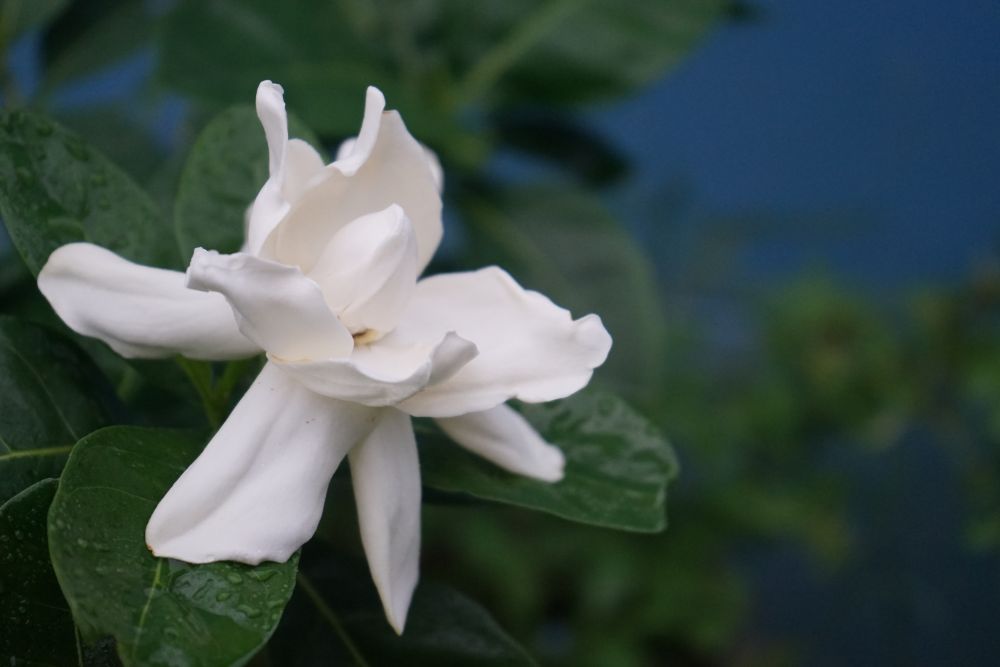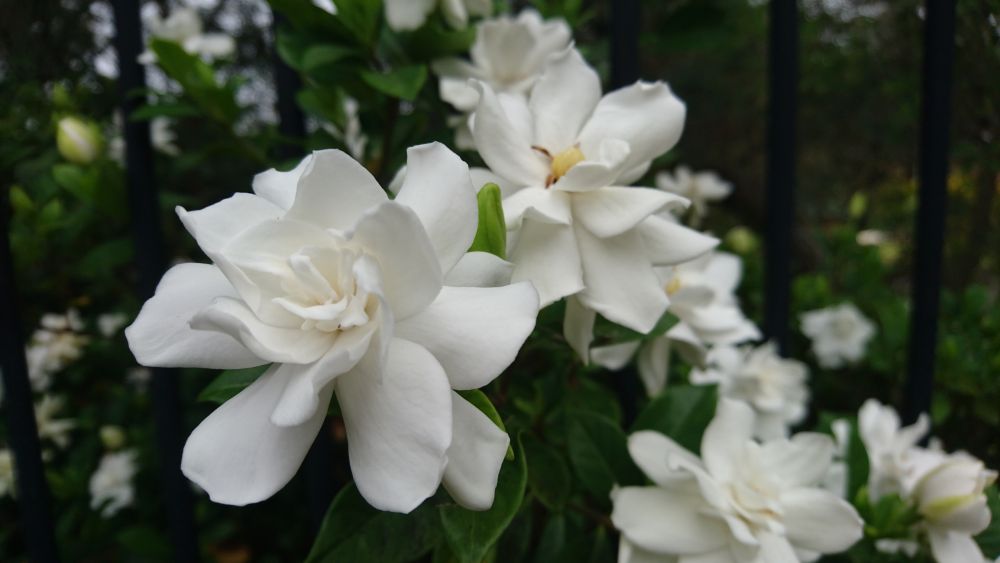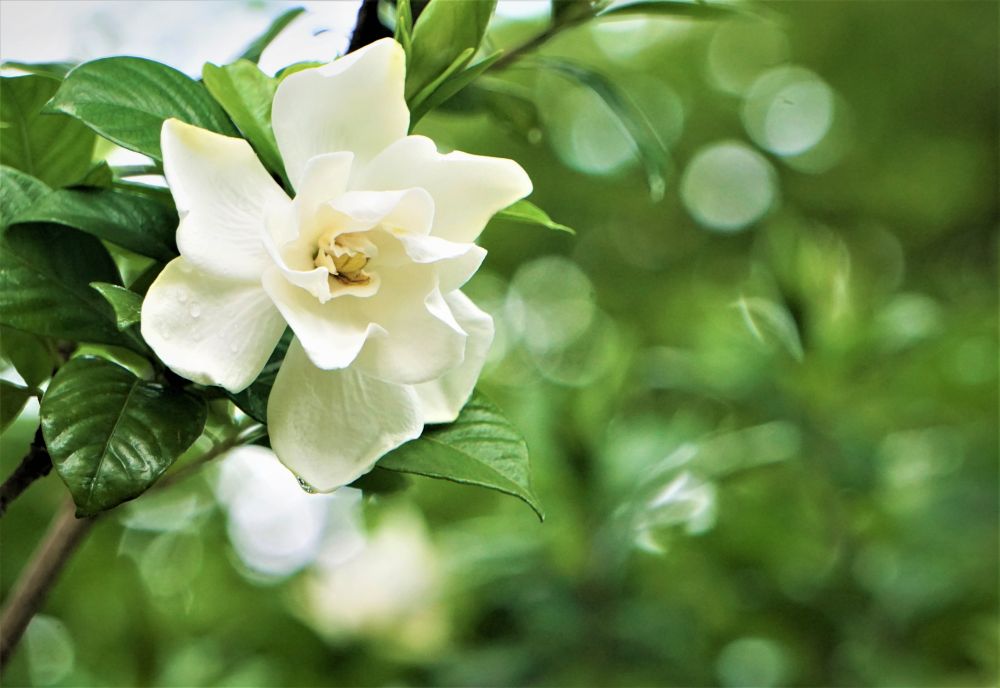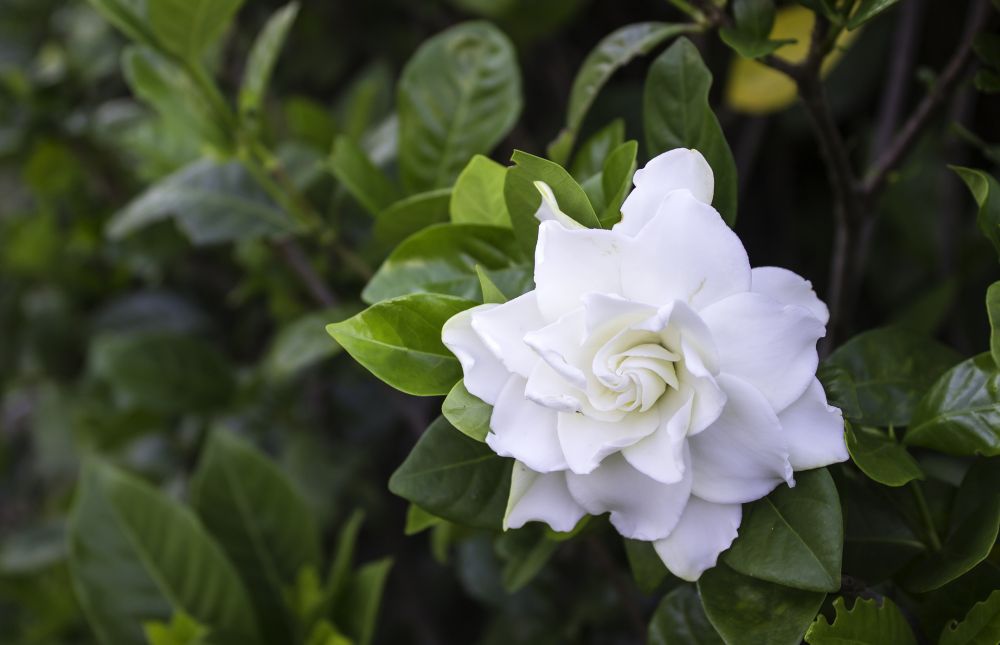How to Grow & Care for Gardenia Plants
Gardenias are shrubby perennials that choose to remain green no matter the adverse conditions. They’re generally known for showy blooms, usually white, and have a strong fragrance. What’s conspicuous about gardenias is even though they’re tropical plants, they don’t tolerate the scorching sun. And since most varieties aren’t frost-hardy, you’ll need to overwinter them when the temperatures outside are freezing.
There are over 200 gardenia varieties that develop in different sizes. Others are perfect for an indoor setting, while others are perfect for ground cover. We found that the most cultivated species is the Gardenia jasminiodes—a dwarf and shrubby perennial native to China and Japan. Let’s check out the tips and suitable conditions for growing gardenia plants indoors and in your garden.
More About Gardenia Plants
Gardenias usually spread in an even and visually appealing pattern. And since they aren’t invasive, trimming them isn’t a daunting task at all. They typically reach between 3′ to 8′ feet tall and grow in a shrub-like texture. These flowering perennials can also grow in tree and dwarf forms. The overall height usually depends on the cultivar type you’re looking to grow. Dwarf gardenia types, for instance, reach anywhere between 5′ inches to 2 feet. And because of its elegant stature, it’s easy to get intimidated anytime you’re thinking of growing this flowering perennial.
The flowers have a delectable scent and usually come out from late spring to early summer, so long as there’s enough warmth and lighting to support the entire blooming phase. However, most growers shy from the high-maintenance gardenia types because of their vulnerability to common pests and diseases that prey on flowering perennials with lush and fleshy foliage.
Favorite Gardenia Varieties
- Gardenia jasminiodes ‘August Beauty’: It’s difficult not to notice its profuse and vigorous flowers that grow in pairs on a single stalk. The variety is a heavy bloomer, and the flowers usually spread up to 3′ inches wide. Its bloom time falls between mid-spring till fall. The evergreen shrub is native to China and Japan. Like most other gardenia types, it prefers exposure to the full sun but with some partial shade.
- Gardenia jasminiodes’ Buttons’: Also known as the Cape Jasmine, this flowering perennial is popularly labeled as a dwarf type because it’s a slow grower and often grows in a compact setting. The leaves of this variety and lance-shaped and have a lustrous appearance throughout the seasons. Its semi-double blooms usually have a yellow button in the center, hence the name. This dwarf variety is ideal for containers.
- Gardenia jasminiodes ‘Aimee’: The Aimee houseplant is arguably one of the largest varieties in the Gardenia species and grows best in USDA hardiness zones 8 to 11. It can reach up to 8′ feet in height. The trademark for this variety ‘First Love®.’ It’s typical for the plant to bloom anytime between late spring till the early weeks of summer.
- Gardenia jasminiodes’ Crown Jewel’: Most growers living outside the preferred zones prefer growing this dwarf variety because of its cold-hardy traits. The Crown Jewel can produce double flowers on each stalk, and the blooms usually stick around for a while, especially when the lighting conditions are favorable. Its creamy-white flowers have a potent fragrance, mainly when growing in mass numbers.
How to Grow Gardenias Indoors
It’s typical for gardenias to have a thirst for warmth and consistent humidity levels. Place the growing medium in a room where temperatures generally range from 55 to 75 degrees Fahrenheit. Growing gardenias in containers is a plus since you can move them. You, therefore, want to bring your gardenias indoors when the night temperatures seem to fall below 55 degrees Fahrenheit consistently. The foliage also needs access to bright but filtered light.
I like growing my gardenias in tabs over medium size pots because if the roots grow in a compact setting, the woody perennials will develop at a sluggish pace. Anytime there are extreme variations in the weather patterns, say, during winter, you’ll need to move the growing medium to a warmer and brighter location. Gardenias growing indoors will need about 6 to 8 hours of bright light each day.
Gardenia Caring Tips
Soil Requirements
You want to plant your gardenias in the fall or the early weeks of spring. When growing indoors, use potting soil that drains excess moisture relatively fast. Preparing a soil mixture with low pH would help keep this plant alive throughout the seasons because it prefers acidic conditions. It’s best to do a soil test if you’re unsure about the pH levels. So, do you control the soil pH? Calibrating the soil pH is pretty straightforward, and there are natural ways to do that.
Using aluminum or iron sulfates could burn the roots and deteriorate the foliage color. Adding compost would help lower the pH of the potting soil without hurting the plant. And for optimal drainage, you can amend the potting soil with compost and tree barks. Generally, gardenias don’t have the zeal to compete for nutrients desperately, so you want to space them out when planting. The roots, too, will need extra room to spread out and breathe.
Those growing outdoors tend to thrive a lot better in raised beds. Raised garden beds are easy to tweak for drainage, and mulching the top layer won’t seem like a strenuous task. A standard potting mix amended with peat moss would also work as a perfect soil structure when planting your gardenias. If your garden has loamy or sandy soil, dig holes about 2′ feet wide, then fill them with the soil mixture. And when the soil is made of dense clay, mixing with sand would help improve drainage and the rate of aeration.
Potting
When growing gardenias inside containers, it’s best to use a peat-based potting mix. The roots of this woody perennial plant are often prone to transplant shock, so you want to move it into a larger container only when necessary. And the best time for this errand is during the early weeks of spring when the growth hormones are about to bounce back. Transplanting root-bound gardenias also helps prevent stunted growth. Also, make sure to replace the old soil with one that’s revitalized with nutrients and supports drainage reasonably well.
Blooming
During the blooming season, gardenias will produce more vibrant flowers if the temperatures range between 75 to 80 degrees Fahrenheit during the day. Depending on your region, a mature gardenia plant will bloom from spring till summer. However, some varieties tend to bloom as they approach the autumn season. Most gardenia varieties usually have white flowers, and the stalks will sometimes hold double-blooms. The blooms typically have an elegant fragrance, so make sure to place the growing medium somewhere in your living room or close your outdoor patio.
Light & Temperature
Gardenias growing indoors will need lots of bright light. But it would help if you protected the foliage from any intense heat by growing then under partial shade, especially when growing outdoors. Place the growing medium near a window facing south since it provides direct light within a radius of 2 or 3 feet. And since gardenias prefer warmer environments, they generally require temperatures above 60 degrees Fahrenheit.
You might need to tweak the temperature levels, mainly when growing your gardenias indoors. The exact temperature level to stick with throughout the growing season would depend on the foliage color or quality of blooms you want them to have. Any intense heat from the sun will cause damage to the foliage, so it’s best to grow outdoor gardenias inside pots. Excess sun exposure also causes faded flower color. The goal of growing gardenias in pots is to make moving them indoors a lot easier.
Humidity
As you probably know, Gardenias are native to the tropical regions of China. So, it would be essential to mimic the humidity conditions of where this flowering perennial originates from. Apart from acidic soils, gardenias prefer to warm and moist environments. When growing outdoors, mulching the topsoil is an inexpensive way to keep the humidity levels in check. Mulch helps reduce weed growth, soil erosion and creates optimal conditions for moisture retention. On average, these perennial shrubs prefer a humidity level that’s slightly above 60 percent. If you live in a region with a cold climate and dry winter seasons, you might need to make the best use of a humidifier, primarily if your gardenias are growing indoors.
Watering
While this flowering houseplant thrives under humid conditions, you need to moisten the soil only when it feels dry. You might see some flower bud dropping if the soil is waterlogged. Excess moisture getting stuck in the soil breeds harmful fungi that lead to root rot. We highly vouch for drip irrigation because the foliage must not have any moisture. Overhead watering will cause the foliage to suffer from fungal diseases that are sometimes pretty hard to treat. Cut back the watering intervals drastically when it’s winter since the growth hormones will be dormant during this season.
Grooming & Maintenance
During its lifetime, there won’t be any intense grooming routine to do. Get rid of any dead flowers to encourage new growth during the blooming season. Pruning your gardenias while they’re at their tender years will also help them grow in a subtle shape and pattern. After the houseplant is mature enough, you need to prune it back at least two-thirds of its original size once the blooming phase is over.
Fertilizer
You want to feed your gardenias only when the temperatures are warm. Pick a fertilizer that works perfectly for acid-loving plants. The best times to fertilize this flowering perennial is during spring and mid-summer. Feed them only once every three weeks. Avoid using fertilizer during the fall season. Also, when mulching, add some doses of coffee grounds to create a slightly acidic environment for the optimal growth of your gardenia plants.
Fish emulsion and blood meal are pretty solid alternatives if you want to tune the overall soil pH to the plant’s liking. Besides consistent moisture supply in the soil, your gardenias will need significant potassium, phosphorus, and calcium deposits to produce vivid and bright flowers throughout the blooming season. Running a soil test before feeding would help determine the exact nutrients which are missing.
How to Propagate Gardenias
It’s relatively easy to propagate gardenias using stem cuttings. Take the cuttings in the early weeks of spring. Cut them right below the leaf nodes and make sure the stem cuttings are at least 4′ inches long. A publication from the University of Florida recommends sterilizing gardening equipment before propagating to control the spread of diseases. Cuttings with blemishes or look sick will send the entire propagation exercise to a downward spiral. From the onset, the cuttings will be softwood, but they’ll harden over time.
First, get rid of any lower leaves and dip the base part into a rooting hormone to speed up roots development. Next, you want to improve drainage on the potting soil by amending the top layer with a mixture of sand and peat moss. Fill the growing pot with the potting mix, then dig a hole that’s deep enough to cover half the size of the stem cutting. Moisten the soil gently and evenly. Place the container somewhere with bright but filtered light, and aim for an environment with temperatures above 60 degrees Fahrenheit. Keep the mixture moist but not too soggy. The cuttings need to stay in a place with high humidity till they form roots.
Within 4 to 8 weeks, the roots will start to develop. You’ll later need to transplant the cuttings into bigger containers after forming roots. If there’s some resistance after gently pulling the stem cuttings upwards, it suggests the roots have already formed. You can also use seeds to propagate gardenias, but they take a bit longer to develop into mature plants. And when not done correctly, the plants might fail to produce any flowers during the blooming season. Of course, failure to bloom would also arise when you’re propagating using counterfeit seeds.
Common Pests & Diseases
Your gardenia plants might struggle with common pests such as aphids, scale insects, root nematodes, spider mites, whiteflies, and mealybugs. It’s easy to eliminate aphids, mealy bugs, and scale insects by spraying some insecticidal soap on the affected areas. These bugs tend to leave a dark sooty mold on the affected areas. They’re attracted to gardenia varieties because of their fleshy and radiant foliage. Unfortunately, if the infestation is intense, then you risk losing the entire plant. Whiteflies tend to settle on the underside of the leaves. One of the easiest ways to suppress these bugs is by applying neem oil.
You can also use neem oil to treat spider mites. However, freezing temperatures and inconsistent watering patterns will add up to the problems your gardenias are ultimately likely to experience. If the buds start to drop, your gardenias could be susceptible to low humidity levels, underwatering, or overwatering. You, therefore, want to give them the extra moisture they need and check whether the soil structure has poor drainage. Other conditions to watch out for include poor lighting, hot weather, excess fertilizing, as well as nutrient deficiencies.
If the leaves are turning brown, it could be because the soil isn’t acidic enough to enhance the uptake of essential nutrients. Harmful pathogens that spiral up due to overwatering also cause the leaves to have some brown patches. Apart from traces of sooty mold left by pests, the dreaded microbes will cause the leaves to have powdery mildew that spreads even further to reach the stems. You can treat some of these conditions using fungicides.
Where to Grow Gardenias
Gardenia plants are perfect for landscaping. This evergreen shrub develops hardy traits when growing in USDA hardiness zones 8 to 11. So, it can be an ideal fit for bordering or designing spectacular landscapes. Potted gardenias have an arresting stature when growing in porches and patios. The blooms glow even better if there’s a shade to protect them from the scorching sunlight or strong winds.



